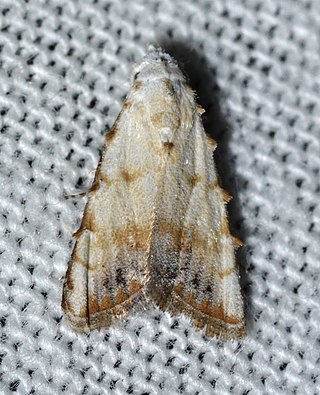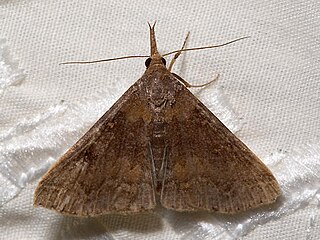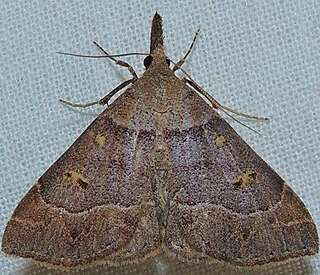
The speckled bush-cricket is a flightless species of bush-cricket belonging to the family Tettigoniidae. The species was originally described as Locusta punctatissima in 1792.

The Herminiinae are a subfamily of moths in the family Erebidae. The members of the subfamily are called litter moths because the caterpillars of most members feed on dead leaves of plants, though others feed on living leaves, and/or the mushrooms of fungi as in the case of genus Idia.

Utetheisa pulchella, the crimson-speckled flunkey, crimson-speckled footman, or crimson-speckled moth, is a moth of the family Erebidae. The species was first described by Carl Linnaeus in his 1758 10th edition of Systema Naturae.

Renia is a genus of litter moths of the family Erebidae erected by Achille Guenée in 1854.

Nola cereella, the sorghum webworm, is a moth of the family Nolidae. It is kin to the Noctuidae, also called Tuft moth due to the presence of its tufted scales. The species was first described by Louis Augustin Guillaume Bosc in 1800. It is found in the southeastern parts of the United States, from Texas to Florida, and north to New York. From North America its range extends southward through Puerto Rico and Suriname down to Argentina.

Renia discoloralis, the discolored renia, is a litter moth of the family Erebidae. The species was first described by Achille Guenée in 1854. It is found in the United States from Missouri to southern New England, south to at least North Carolina and possibly Florida and Texas, but this might be an unnamed relative.

Renia salusalis, the dotted renia, is a litter moth of the family Erebidae. The species was first described by Carl Linnaeus in his 1758 10th edition of Systema Naturae. It is found in the United States from Colorado, Ohio and Connecticut, south to Florida and Texas.

Renia factiosalis, the dark-banded renia or sociable renia moth, is a litter moth of the family Erebidae. The species was first described by Francis Walker in 1859. It is found from southern Canada to Florida and Texas.

Renia flavipunctalis, the yellow-dotted renia, yellow-spotted renia or even-lined renia, is a litter moth of the family Erebidae. The species was first described by Carl Geyer in 1832. It is found from southern Canada to Florida and Texas.
Renia nemoralis, the tardy renia or chocolate renia moth, is a litter moth of the family Erebidae. It is found in the US from Illinois to south-eastern Massachusetts south to Florida and Texas. The species was first described by William Barnes and James Halliday McDunnough in 1918.

Renia fraternalis, the fraternal renia, is a litter moth of the family Erebidae. The species was first described by J. B. Smith in 1895. It is found in North America, including New York, Oklahoma, Arkansas, South Carolina and Florida.
Renia mortualis is a litter moth of the family Erebidae. It is found in North America, including and possibly limited to the Huachuca Mountains of Arizona. The species was first described by William Barnes and James Halliday McDunnough in 1912.

Renia sobrialis, the sober renia, is a litter moth of the family Erebidae. The species was first described by Francis Walker in 1859. It is found from Nova Scotia to Florida, west to Mississippi and Minnesota.
Setomorpha is a monotypic moth genus in the family Tineidae described by Philipp Christoph Zeller in 1852. Its only species, Setomorpha rutella, the tropical tobacco moth, was described by the same author in the same year. It is a widely spread species that has been distributed by commerce over much of the warmer parts of Africa, Eurasia, Malaysia, Australia, many Pacific islands and North and South America.

Caradrina multifera, the speckled rustic moth, is a moth of the family Noctuidae. The species was first described by Francis Walker in 1857. It is found in North America from Newfoundland to North Carolina and Tennessee and west to Minnesota and Manitoba. It is also present in British Columbia and Washington.

Lycia ursaria, the stout spanworm moth or bear, is a moth of the family Geometridae. The species was first described by Francis Walker in 1860. It is found in southern Canada and the northern United States, south to New Jersey and Iowa.

Clydonopteron sacculana, the trumpet vine moth, is a species of snout moth. It was described by Louis Augustin Guillaume Bosc in 1800. It is found in the West Indies, Brazil and Argentina. In North America, it is found from Washington, DC to Florida, west to Missouri and Texas.

Petrophila canadensis, the Canadian petrophila moth, is a moth in the family Crambidae. It was described by Eugene G. Munroe in 1972. It is found in North America, where it has been recorded from southern Canada and the north-eastern United States.

Orthosia hibisci, the speckled green fruitworm moth, is a moth of the family Noctuidae. It is found in most of North America, except in desert regions. The habitat consists of moist forests, riparian, agricultural and urban areas.

Euchlaena marginaria, the ochre euchlaena moth, is a moth of the family Geometridae. The species was first described by Charles Sedgwick Minot in 1869. It is found in North America, where it has been recorded from south-central British Columbia and Idaho to Nova Scotia and south to Florida and Missouri. The habitat consists of mixed wood and deciduous forests.

















